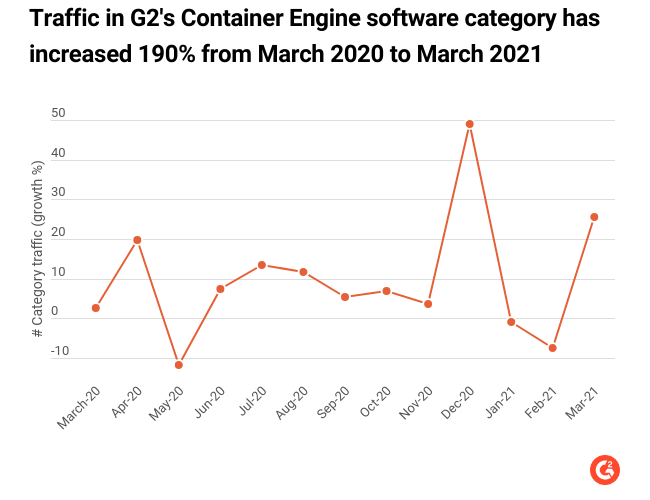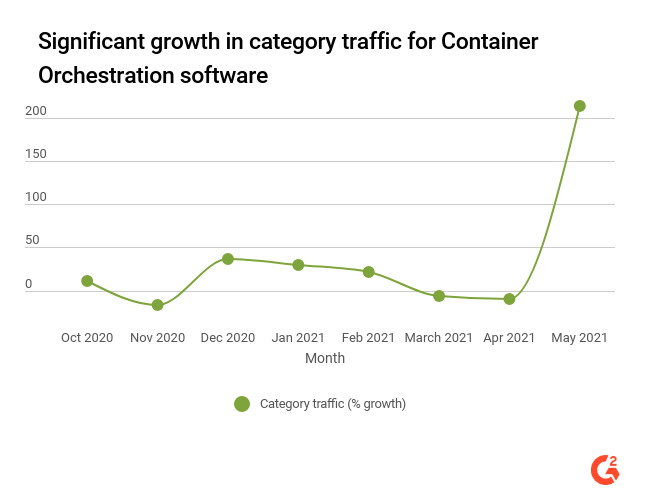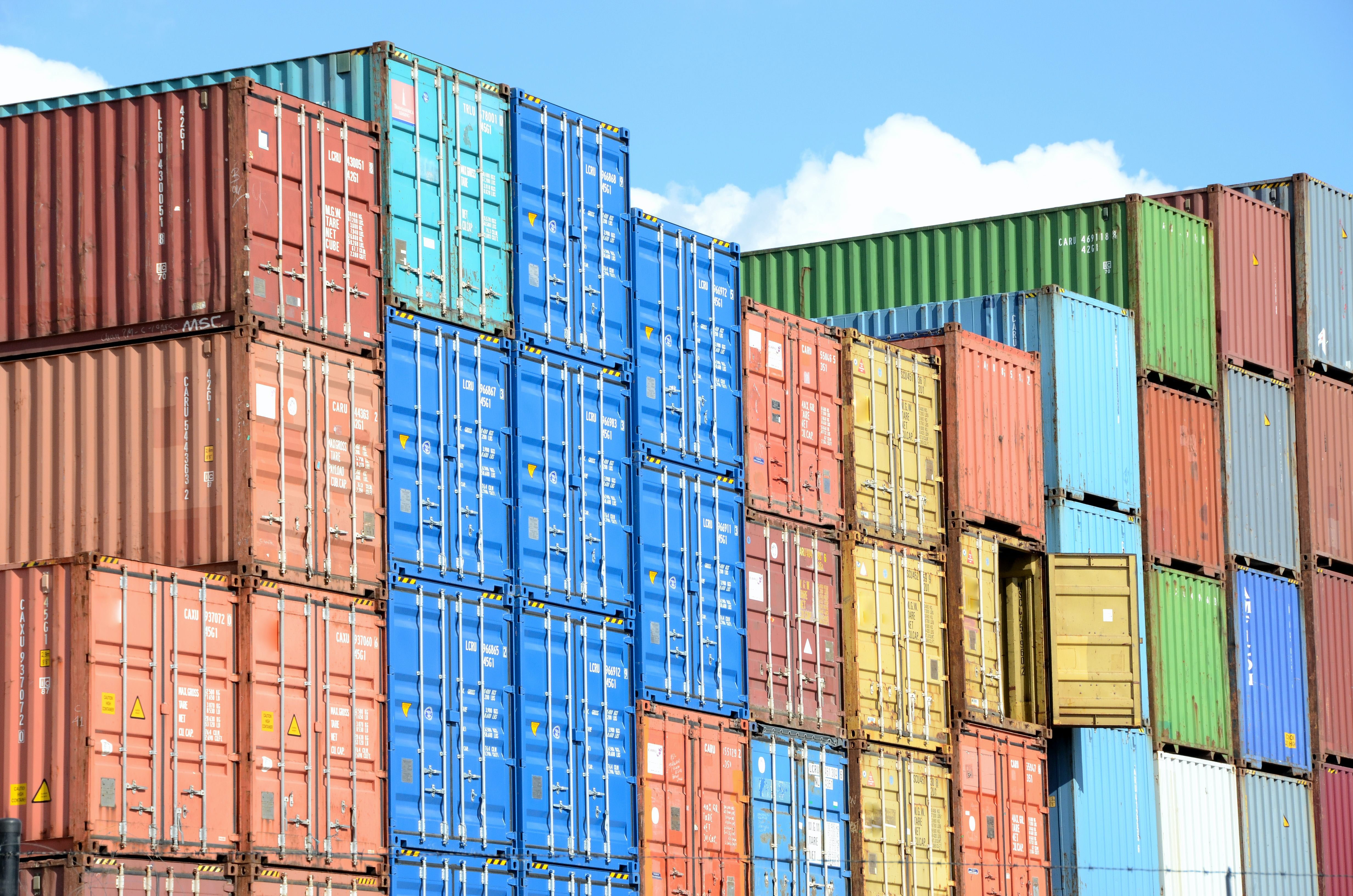Wenn Sie zu einer Entwicklerkonferenz irgendwo auf der Welt gehen, werden definitiv Erwähnungen von Docker, Kubernetes und anderen Namen, die direkt aus einer nautischen Umgebung zu stammen scheinen, zu hören sein. Bei so vielen Informationen ist es natürlich, verwirrt darüber zu sein, was Containerisierung und ihre Beispiele sind und warum sie heute so relevant ist.
In diesem Artikel werde ich versuchen, die Containerisierung einfach zu machen und Fragen zu beantworten wie: Was ist das, warum wächst der Markt für diese Software so schnell und was sind die neuesten Trends in der Containerisierungssoftware laut G2-Daten.
Verständnis der Containerisierung
Was ist Containerisierungssoftware?
Containerisierungssoftware wird als eine Art von Betriebssystem-Virtualisierungssoftware definiert, in der verschiedene Anwendungen in isolierten oder abgeschotteten Bereichen, sogenannten Containern, ausgeführt werden, die dasselbe Betriebssystem zum Laufen nutzen. Es kann als vollständig verpackte Computersystemsoftware betrachtet werden.
Ist das also wie ein Schiffscontainer?
Ja! Fast alle Artikel über Containerisierung zeigen ein Bild eines Schiffscontainers, und das ist beabsichtigt. Schiffscontainer werden verwendet, um Dinge auf der ganzen Welt zu transportieren. Die Schifffahrtsindustrie hat eine standardisierte Größe für diese Container festgelegt, was es einfach macht, Container auf Schiffen, Zügen und Lastwagen zu transportieren. Der Inhalt der Container spielt keine Rolle.
Ähnlich ist ein Softwarecontainer ein standardisiertes Softwarepaket. Alle Anforderungen, um die Software auszuführen, sind bereits im Container vorhanden. Dazu gehören alle Bibliotheken, Einstellungen oder Werkzeuge, die erforderlich sind, damit die Software in der Containerumgebung läuft. Der Benutzer muss nur den Code und alle zugehörigen Software in den Container packen, der dann auf jeder Cloud-Computing-Plattform ausgeführt werden kann.
Was macht Containerisierung für Unternehmen heute relevant?
Containerisierung ist zu einem heißen Thema geworden – entweder beginnen einige Unternehmen ihre Reise in die Containerisierung oder einige nutzen sie bereits in großem Maßstab. Unternehmen bewegen sich in diesen Bereich, da damit mehrere positive Ergebnisse verbunden sind. Einige der Hauptvorteile sind:
Freiheit: Dies ist der Hauptvorteil der Containerisierung. Ein Benutzer kann jede Anwendung auf jeder Cloud verpacken und ausführen, da das Standardformat eines Containers dasselbe ist. Benutzer können Arbeitslasten ihrer Wahl in jede Cloud-Computing-Umgebung (öffentliche, private oder hybride Cloud) verschieben, um sicherzustellen, dass ihre IT-Umgebung Agilität, Flexibilität und Skalierbarkeit unterstützt, wenn dies vom Kunden benötigt wird. Darüber hinaus, da der Benutzer alle Werkzeuge zur Verfügung hat, die erforderlich sind, um die Anwendung innerhalb des Containers bereitzustellen, wird es einfacher, jede gewünschte Anwendung auszuführen.
Schnellere Markteinführung: Mit der Freiheit, jede Anwendung auszuführen, können Unternehmen auch neue Anwendungen entwickeln und testen. Unternehmen können neue Dienste beschleunigen und die betriebliche Agilität verbessern. Der Weg von der Entwicklung zur Bereitstellung ist viel schneller, was zu einer verbesserten Markteinführungszeit führt.
Betriebliche Effizienz: Da verschiedene Anwendungen durch ein einziges Betriebsmodell gesteuert werden, ermöglicht es effizientere Abläufe zur Verwaltung zahlreicher Anwendungen.
Für Entwickler ist es klar, dass ihre Software, egal wo sie bereitgestellt wird, immer eine Umgebung haben wird, in der sie ausgeführt werden kann. Darüber hinaus ermöglichen Container eine weitere Funktion, die als Microservices bekannt ist, bei der eine große Anwendung in kleinere Teile zerlegt werden kann, die miteinander kommunizieren können. Ein Unternehmen kann verschiedene Teams einsetzen, um verschiedene Teile effizienter zu verwalten, und solange es keine größeren Änderungen gibt, kann jeder Teil unabhängig arbeiten. Dies ermöglicht verbesserte Testmöglichkeiten, schnellere Bereitstellungszeiten und verbesserte Effizienz.
Docker, Kubernetes – schon verwirrt?
Jetzt wissen wir, was Container sind, also sprechen wir über das Wort, das am meisten damit in Verbindung gebracht wird – Docker.
Docker (jetzt von Mirantis übernommen) ist eine Open-Source-Containerisierungsplattform, die verwendet werden kann, um Container zu erstellen und auszuführen. Docker ermöglicht es dem Benutzer, jede Anwendung in der Cloud zu entwickeln und auszuführen. Da es Open Source ist, verhindert es jegliche Anbieterbindung, und ein Benutzer kann seine Anwendung jederzeit in eine neue Containerumgebung verschieben.
Es ist einfach, einen Container zu verwalten, da alle Zeit und Ressourcen darauf gerichtet werden können, ihn zu verwalten. Aber was passiert, wenn eine Menge neuer Container erstellt werden? Die Verwaltung wird schwierig und könnte zu Chaos führen. Container-Orchestrierungssoftware stellt sicher, dass Benutzer nicht verrückt werden, während sie mehrere Container erstellen. Container-Orchestrierungssoftware ermöglicht es Benutzern, alle Container nach Bedarf zu steuern und zu bewegen. Genau wie ein Dirigent eines Orchesters entscheiden würde, wie viele Geigen spielen sollen, wie laut jedes Instrument ist und wer zuerst beginnt, funktioniert die Container-Orchestrierungssoftware auf die gleiche Weise. Die Software entscheidet, wie Ressourcen bereitgestellt werden, welche Microservices benötigt werden und wie alle anderen Anforderungen verwaltet werden.
Container-Orchestrierung führt uns zu einem weiteren oft verwendeten Begriff – Kubernetes.
Kubernetes ist eine Container-Orchestrierungssoftware, die verschiedene Containerumgebungen verwaltet. Zurück zu unserem Schiffsanalogon von früher, Kubernetes ist der Kran, um all diese Schiffscontainer zu bewegen!
Fun Fact, der Name Kubernetes hat griechischen Ursprung und bedeutet Steuermann oder Pilot oder „Segelmeister“.
Kubernetes stellt sicher, dass alle Container funktionieren. Wenn es Fehler gibt, führt es einen automatisierten Prozess zum Neustart durch oder ergreift Abhilfemaßnahmen. Es verfolgt, wann Anwendungen aktualisiert oder skaliert werden müssen. Es überwacht die Gesundheit des Containers. Es kann sogar Container „töten“, die nicht ansprechbar oder gesund sind, und diese Anwendungen auf einen funktionierenden Container verschieben.
Ist eine virtuelle Maschine (VM) dann dasselbe?
Nein! In einer VM-Umgebung erstellt ein Benutzer eine „virtuelle Umgebung“, um verschiedene Software auf einem einzigen Computer auszuführen. Im Gegensatz dazu trennt ein Container die Software von der Umgebung und dem Betriebssystem, was bedeutet, dass sie überall oder auf jeder Cloud ausgeführt werden kann. Sie enthalten nur Frameworks, Bibliotheken und alle zugehörigen Technologien, die erforderlich sind, um die Anwendung im Container auszuführen.
Ich weiß jetzt, was Container sind, aber wie fange ich an?
Am 20. Juli 1969 sagte Neil Armstrong berühmt, als er seinen linken Fuß auf den Mond setzte: „Das ist ein kleiner Schritt für einen Menschen, aber ein großer Sprung für die Menschheit.“ Für ein Unternehmen ist es eine gute Idee, die Containerreise in seinen Fußstapfen (Wortspiel beabsichtigt) zu beginnen. Es kann wünschenswert sein, mit einem Container zu beginnen, um zu verstehen, wie er funktioniert, die Anwendungen, die laufen, und alle Softwarefähigkeiten, die im Container verankert sind und dem Entwickler zur Verfügung stehen.
| Hier sind einige Möglichkeiten, wie ein Benutzer mit der Containerisierung beginnen kann: |
|
Trends in der Containerisierung: Was sagen die G2-Daten?
Auf dem G2-Marktplatz enthält die Kategorie Containerisierungssoftware mehrere Kategorien, die Käufer erkunden können.
Containerisierungssoftware-Kategorien auf G2 umfassen:
Der Verkehr zur Kategorie Container-Engine-Software auf G2 hat ein signifikantes Wachstum verzeichnet – von April 2020 bis März 2021 um 142 % gestiegen. Da die Pandemie eine enorme Nachfrage nach Cloud-Computing-Diensten geschaffen hat, begannen Gespräche über Containerisierung in der Cloud an Fahrt zu gewinnen, da mehrere Unternehmen nach schnelleren Wegen suchten, um ihre Anwendungen zu entwickeln und bereitzustellen, lange bevor ihre Konkurrenten und einen Vorteil zu erlangen.

Die Kategorie Container-Orchestrierungssoftware hat im letzten Monat ebenfalls ein enormes Wachstum verzeichnet. G2 sah im Mai 2021 einen Anstieg des durchschnittlichen Kategorieverkehrs, der im Vergleich zum Verkehr im Oktober 2020 um 380,46 % zunahm.

Ein solcher Anstieg des Verkehrs kann auf einige große Ankündigungen zurückgeführt werden, die im Mai 2021 im Bereich der Containerisierung zu sehen waren. Zum Beispiel kündigte Amazon die allgemeine Verfügbarkeit von Amazon ECS Anywhere an. Diese Software fungiert als Erweiterung des Amazon Elastic Container Service (Amazon ECS). Mit ECS Anywhere können Kunden mehrere containerbasierte Apps vor Ort mit denselben APIs, Arbeitslastmanagement und -planung, Überwachung, Bereitstellung und anderen Aktivitäten ausführen und verwalten, die idealerweise mit ECS verwendet wurden. Das bedeutet, dass Kunden jetzt Anwendungen in containerisierten Umgebungen auf ihrer lokalen Infrastruktur skalieren können und nicht vollständig auf die Cloud angewiesen sind.
Mit solchen neuen und laufenden Investitionen in diesem Bereich wird der Markt für Containerisierung voraussichtlich erheblich wachsen, da Unternehmen wettbewerbsfähiger werden und die Markteinführungszeit für Apps und Produkte entscheidend bleibt.
Möchten Sie mehr über Containerverwaltungssoftware erfahren? Erkunden Sie Containerverwaltung Produkte.

Preethica Furtado
Preethica is a Market Research Manager at G2 focused on the cybersecurity, privacy and ERP space. Prior to joining G2, Preethica spent three years in market research for enterprise systems, cloud forecasting, and workstations. She has written research reports for both the semiconductor and telecommunication industries. Her interest in technology led her to combine that with building a challenging career. She enjoys reading, writing blogs and poems, and traveling in her free time.
